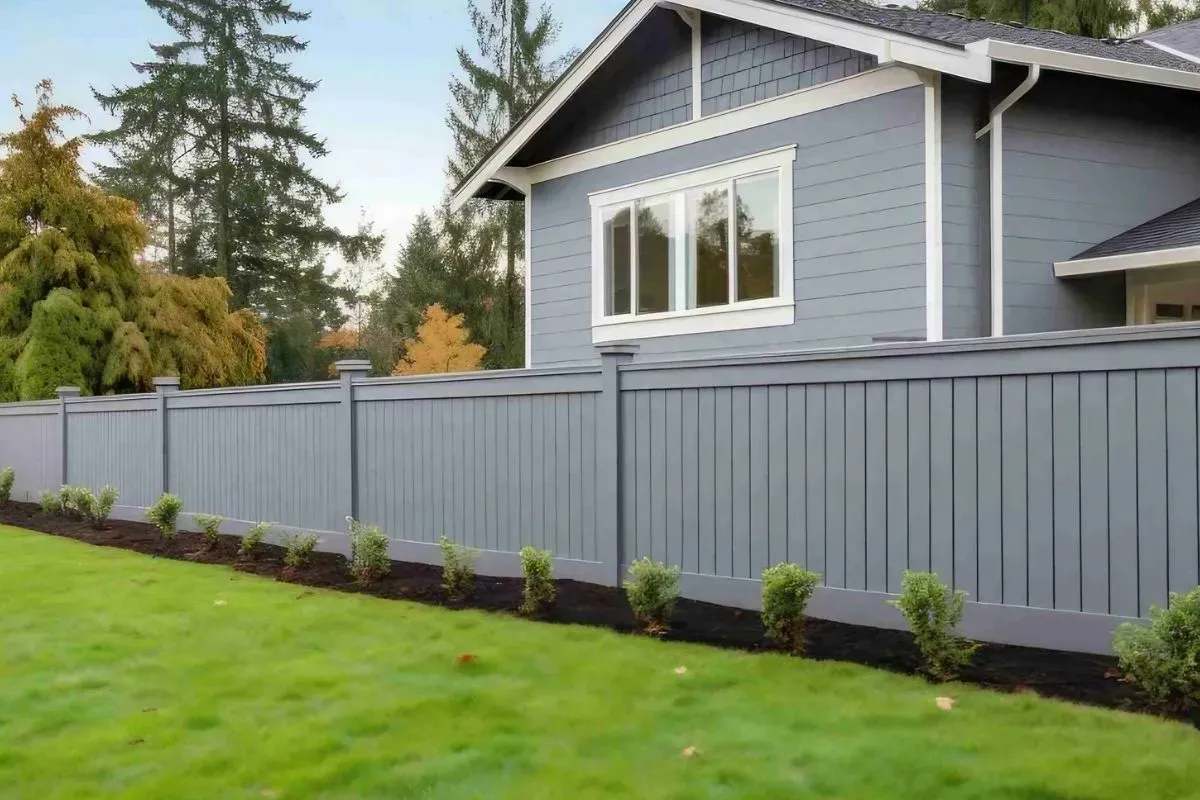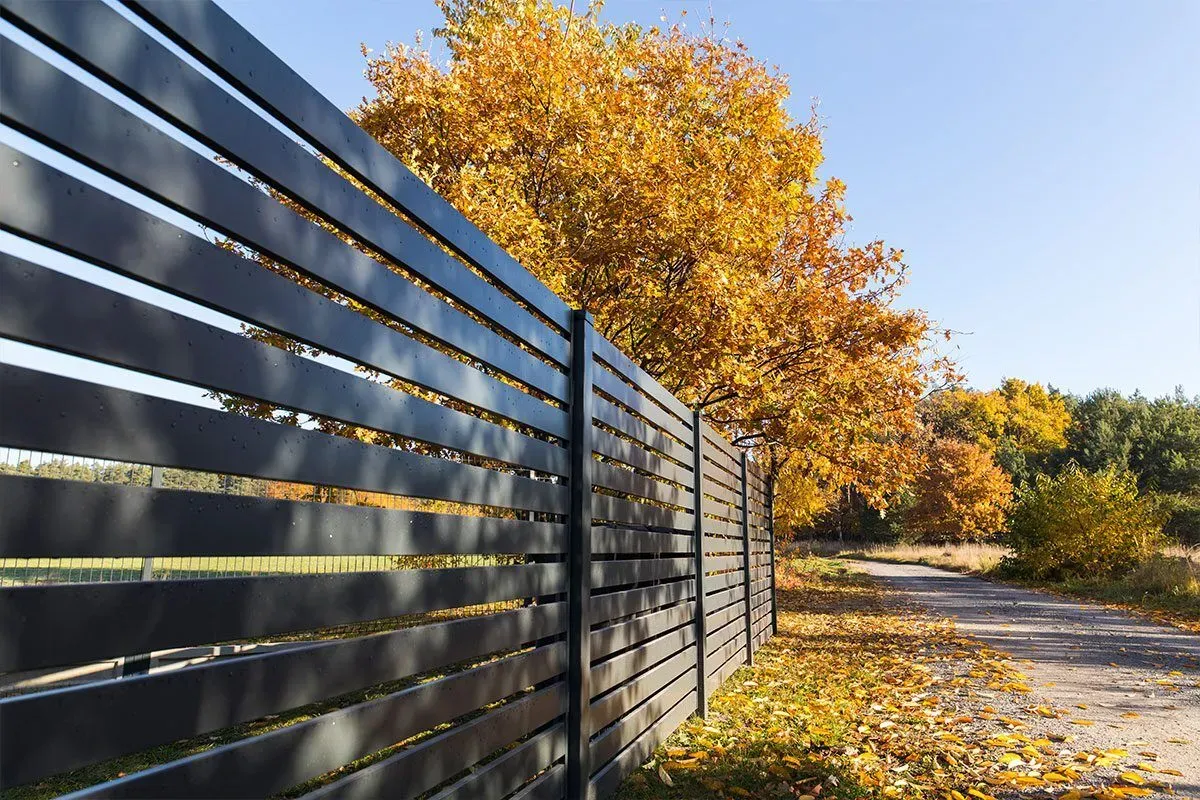Ask any Millennial or Gen X-er, and there’s a good chance they’ll share fond memories about playing outside with neighborhood friends until the street lamps come on. Your older parents might tell you about block parties and social clubs in their old neighborhood. But if you drive through a neighborhood on a sunny summer day today, odds are you won’t see many people out.
We set out to determine if there’s truth to the sentiment that neighbors aren’t as connected now as they used to be. We surveyed more than 1,000 Americans to learn more about their interactions with their neighbors and found that while most people aren’t interacting with their neighbors as much as they may have done in the past, they still value having them.
Read on to learn how Americans feel about privacy and their neighbors.
Key Takeaways:
- 65% of people admit to hiding from their neighbors.
- 48% of people only interact with their neighbors monthly or less.
- Only 17% of Americans trust their neighbor with a house key, although most trust their neighbors at least enough to ask them for a small favor.
Majority of Americans Hide From Their Neighbors
More than two-thirds of respondents report hiding from their neighbors at least once.
The most common neighbor avoidance techniques are as follows:
- Pretending you don’t see them (37%).
- Staying inside when they’re outside (34%).
- Acting like you’re not home (26%).
- Wearing headphones while outside (21%).
- Acting like you’re on the phone (21%).
Younger generations are nearly twice as likely to avoid their neighbors than people over 60. This may be due to various factors, such as their increased likelihood of living in apartments where privacy is minimal or the fact that younger generations socialize more online than in person.
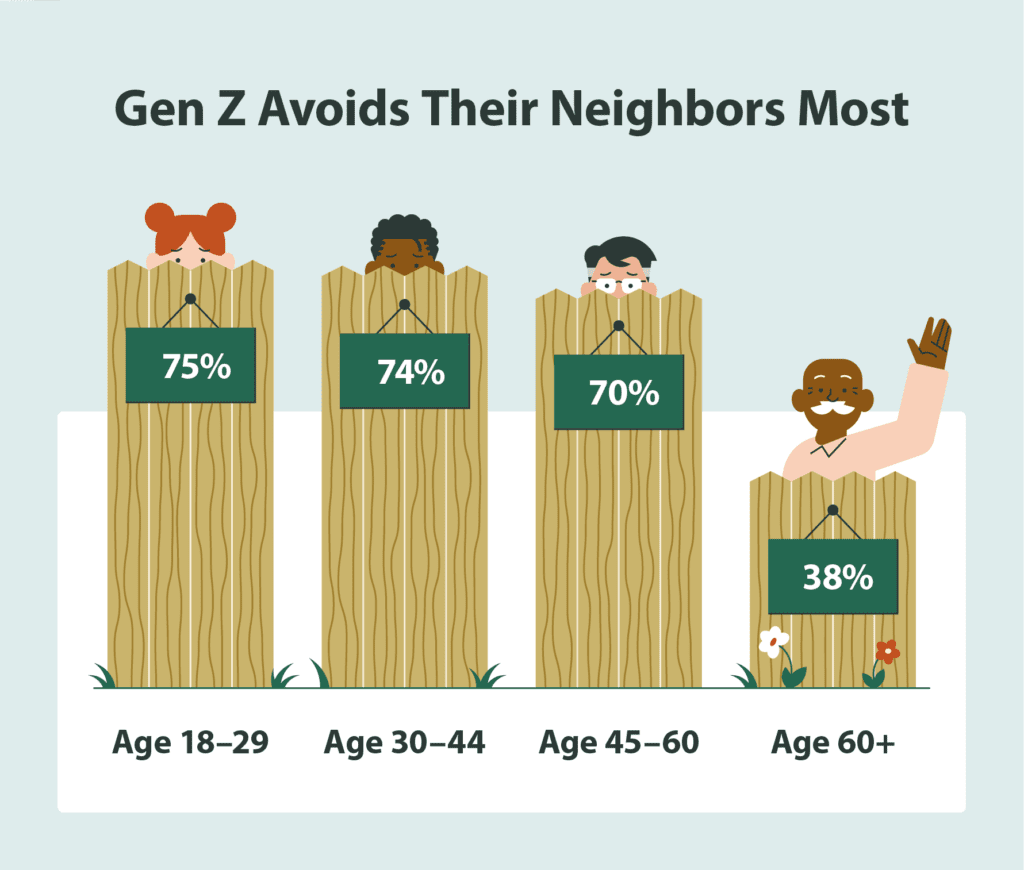
Some avoidance strategies may not be as effective. Listening to a podcast while weeding your garden tells most people that you aren’t in the mood to chat, but a determined neighbor can still walk over and start discussing the latest neighborhood drama.
Other strategies are effective but negatively impact your ability to enjoy your outdoor spaces. Many people want to use their backyards to host events or enjoy summer evenings making s’mores by the fire pit, so staying inside when neighbors are out isn’t always an option.
Adding a privacy fence to your yard can help you avoid your neighbors without having to pretend you’re on your phone or hiding inside. You can also make an existing fence taller if your current fence doesn’t provide enough privacy.
Nearly Half of People Interact With Their Neighbors Monthly or Less
Research shows people are spending more time than ever at home, but they’re not spending it interacting with their neighbors. According to our survey, 48% of people only interact with their neighbors monthly or less, and nearly a third rarely interact with them.
Interesting insights:
- Men are more likely to interact with neighbors than women, with 54% of men interacting at least weekly compared to 51% of women.
- 60% of people over 60 interact with their neighbors at least a few times a week.
- Nearly 40% of people aged 18-29 rarely or never interact with their neighbors.
There are various reasons why people might not interact with their neighbors frequently:
- We live in a fast-paced world filled with long working hours, kids in multiple extracurriculars, and other stresses. People may prefer to unwind in the evening and on the weekends with their family, relax alone, or enjoy hobbies that don’t include catching up on neighborhood gossip.
- Some people may simply wish to avoid conflict. According to our survey, roughly 46% of respondents have had a dispute with a neighbor in the past. They may also just want to avoid arguments and disagreements if they don’t see eye to eye with their neighbors.
81% of People Value Privacy From Their Neighbors
Most Americans value at least some privacy from their neighbors, with only 19% claiming privacy isn’t a concern. Most respondents (35%) indicated they want some level of privacy, but they don’t mind interacting occasionally with neighbors.
When asked about privacy features becoming increasingly popular, Nicholas McMillan, founder and owner of Hire Realty LLC, says homeowners are looking for “sound-reducing windows, privacy landscaping (trees and tall hedges), advanced security systems, and smart home technology that gives more control over who can enter the house.”
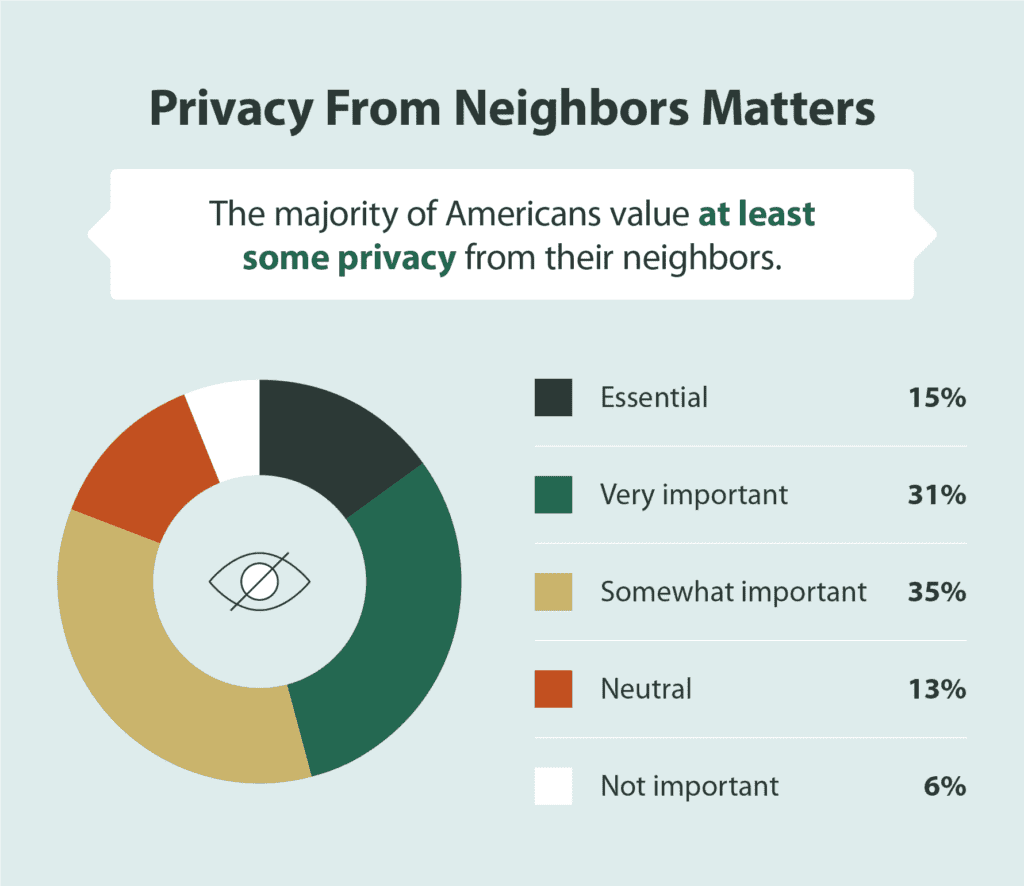
Fortunately, there are a few steps you can take to increase your privacy when you’re outside:
- 26% of respondents report installing a fence or privacy screen.
- 24% of respondents planted trees for additional privacy.
- 15% of respondents arranged their patio furniture or patio layout to increase privacy.
- 6% of respondents added soundproofing materials to their patio or yard.
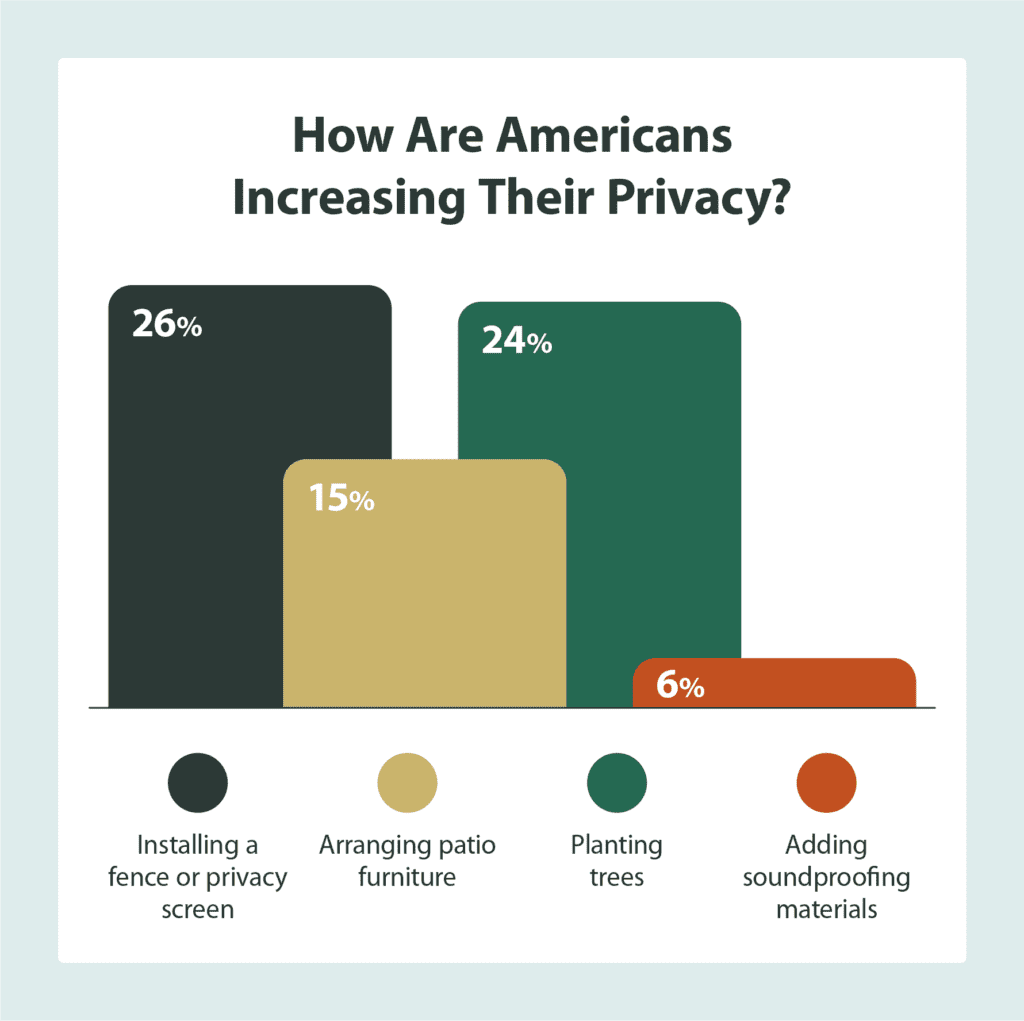
You can determine the level of privacy you want based on the height or style of your fence. If you just want a little privacy, opt for a 4-6 foot wooden fence. To ensure no one comes into your yard, you can add a security fence (if your neighborhood bylaws allow it).
Only 17% of People Trust Their Neighbors With a House Key
Most Americans (64%) trust their neighbors at least enough to ask for a small favor, but only 17% would trust their neighbors with a house key. This trust seems to increase with age — people 60 or older are twice as likely to leave a house key with a neighbor than people aged 18-29.
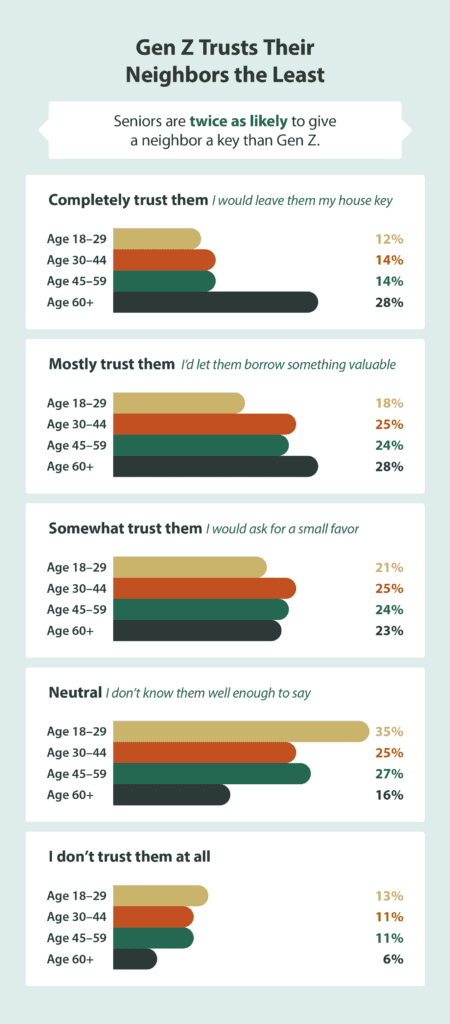
Building the trust required to let someone have full access to your home takes time and effort. It makes sense that relatively few people would trust their neighbors when more than half of Americans hide from their neighbors and most only see their neighbors monthly or less.
No matter how much you trust your neighbors, you may not want them in your backyard, especially if you have backyard elements that might cause accidents, like a swing set or a pool. But it can be harder to keep them out of your backyard than your home. A fence is the best way to keep your neighbors out when you aren’t home.
Noise Complaints Are the Most Common Disagreement With a Neighbor
Fortunately, 54% of our respondents reported never having a dispute with a neighbor, suggesting that despite not interacting much with neighbors, most people get along with them. Women report fewer disputes than men, with only 43% experiencing a dispute compared to 49% of men.
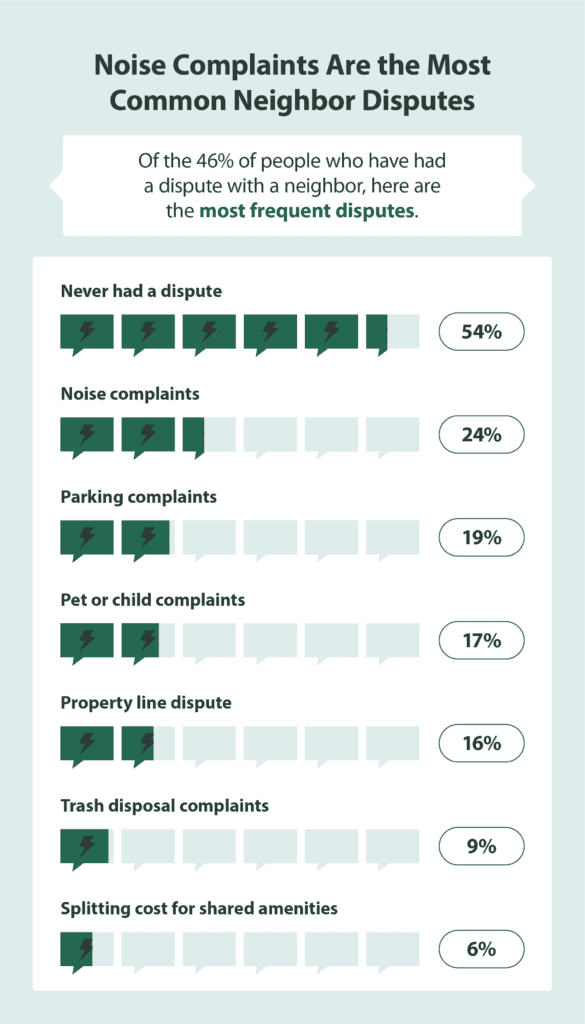
The most common property dispute reported by our respondents was noise complaints. While it can be challenging to get people to keep the noise level down all the time, you can minimize the impact of some noise with a privacy fence.
If you are making noise in your backyard, the wood of a privacy fence can absorb or reflect the sound waves back to you to minimize how much your neighbors can hear.
Property line disputes were also common, with 16% of respondents reporting having had one with a neighbor. Property disputes include any of the following:
- Disagreements about boundary lines.
- Conflicts over who rightfully owns property, often occurring through unclear wills or sales histories. This can lead to issues when something, such as a fence, is in need of repair.
- Encroachment when one neighbor builds something, such as a fence or shed, that extends into another neighbor’s property.
- Zoning issues regarding how a property is used.
If you and your neighbor are concerned about knowing exactly where the property line is, you can share a fence with a neighbor. Just ensure you have a land survey done before installing it. You don’t want to pay to build a fence only to discover it’s one foot over the property line, and you need to tear it down and rebuild it.
Other common conflicts with neighbors include:
- Parking complaints.
- Pet or child complaints.
- Trash disposal complaints.
Women are less likely to have disputes than men, with just over half of women saying they’ve never actually had an altercation with a neighbor. Similarly, nearly 60% of people over 60 say they’ve never had a dispute, compared to a much smaller percentage of younger adults.
60% of People Would Rather Put Up a Fence Than Not Have Neighbors
Just because Americans value privacy and avoid their neighbors doesn’t mean they don’t want neighbors. More than half of respondents (60%) reported that they’d rather put up a fence to maintain privacy than buy a property with no neighbors.

This suggests that the benefits of neighbors outweigh any potential privacy concerns. Neighbors are there when you need to borrow a cup of sugar or if you experience an emergency such as a fire and need someone to call 911.
They offer a sense of security when you’re away, knowing that someone is keeping an eye on things or watering your plants. Plus, even without speaking with them every day, neighbors provide a basic level of social connection that keeps us all from being completely isolated.
Most people are looking for ways to keep connecting with the people around them while still establishing a sense of privacy.
Martin Boonzaayer, CEO of The Trusted Homebuyer, explains the following ways he’s seen homeowners balance privacy and community:
- Gated communities: These offer a nice mix of social interaction and added security, giving people a sense of community without sacrificing too much privacy.
- Large plots in community settings: Opting for homes with larger plots in community-oriented developments lets buyers enjoy community amenities and events while keeping their living space private.
- Getting involved in community governance: Being active in HOA meetings or neighborhood associations gives buyers a say in rules that impact privacy, like guidelines on fences or noise control.
- Creating private zones: Buyers often design their homes with private areas, like secluded patios or private gardens, so they can enjoy both socializing with neighbors and having their own quiet retreat.
Keep Your Backyard Private With Residential Fencing
The survey data shows that Americans value their privacy and may not socialize with their neighbors often, but this varies by person and neighborhood. There are some very close-knit neighborhoods where you’ll still find kids playing Ghosts in the Graveyard after dark or celebrating the Fourth of July with sparklers and a cookout.
Whether your neighborhood celebrates every holiday with a block party or your neighborhood prefers to interact with smiles and waves from afar, a fence can certainly increase your backyard’s privacy. Get your free estimate today.
Methodology
The survey of over 1,000 adults aged 18+ was conducted via SurveyMonkey Audience for Top Rail Fence on May 15, 2024. Data is unweighted and the margin of error is approximately +/-3% for the overall sample with a 95% confidence level.
